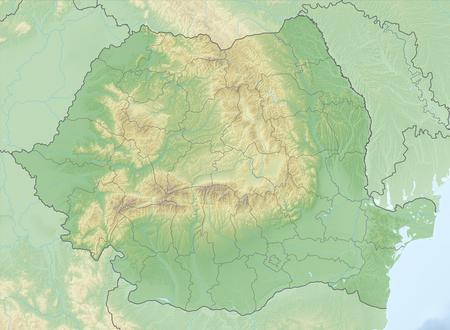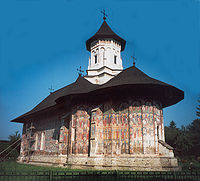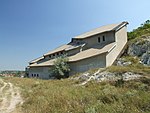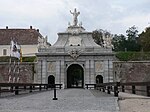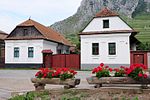World Heritage in Romania
World Heritage Sites in Romania |
The world heritage in Romania (as of 2018) includes eight UNESCO world heritage sites , including six world cultural heritage sites and two world natural heritage sites. Romania acceded to the World Heritage Convention in 1990, and the first World Heritage site was added to the World Heritage List in 1991. The last World Heritage site to date was registered in 2017.
World heritage sites
The following table lists the UNESCO World Heritage Sites in Romania in chronological order according to the year of their inclusion in the World Heritage List (K - cultural heritage, N - natural heritage, K / N - mixed, (R) - on the Red List of World Heritage in Danger ).
![]() Map with all coordinates of the World Heritage Sites: OSM
Map with all coordinates of the World Heritage Sites: OSM
| image | designation | year | Type | Ref. | description |
|---|---|---|---|---|---|
|
Danube Delta ( location ) |
1991 | N | 588 | The Danube Delta Biosphere Reserve is located in the area where the Danube flows into the Black Sea . 82.5 percent of it is in the Romanian part of the Dobruja region and 17.5 percent in the Ukraine . | |
| Villages with fortified churches in Transylvania (Transylvania) | 1993, expanded 1999 | K | 596 | The fortified churches were in Transylvania to defend against Turks and Tatars built -Einfälle. The seven villages of Biertan (Birthälm) , Câlnic (Kelling) , Dârjiu (Ders) , Prejmer (Tartlau) , Saschiz (Keisd) , Valea Viilor (wormhole) and Viscri (Deutsch-Weißkirch) are part of the world heritage . | |
|
Horezu Monastery ( location ) |
1993 | K | 597 | The Horezu Monastery is in the west of Wallachia at the foot of the Carpathian Mountains . The monastery was founded in 1690 by the then Prince of Wallachia Constantin Brâncoveanu (1654–1714). The monastery is built in the Brâncoveanu style . | |
| Churches in Moldova | 1993 | K | 598 | The Moldavian Monasteries are a group of Romanian Orthodox monasteries in southern Bucovina . Its construction was initiated in the 15th and 16th centuries in what was then the Principality of Moldova by Stefan the Great and his successors around the official seat of Suceava . The world heritage includes the eight churches Church of the Beheading of John the Baptist in Arbore , Church of the Dormition in Humor , Church of the Annunciation in Moldovița , Church of the Exaltation of the Cross in Pătrăuți , St. Nicholas Church in Probota , St. George's Church in Suceava , Church of the Resurrection in Sucevița and St. George's Church in Vorone . | |
|
Historic center of Sighișoara (Schäßburg) ( location ) |
1999 | K | 902 | The "historical center", the so-called castle, was built in the 17th century by the Transylvanian Saxons under the Latin name Castrum Sex . | |
| Wooden churches of Maramureș (Marmarosch) | 1999 | K | 904 | The wooden churches in Maramureș are around 60 church buildings in the Maramureș region, around 45 of them in Romania and around 15 in Ukraine . Eight of them in the Romanian Maramureş district have been declared a World Heritage Site by UNESCO: Bârsana , wooden church by Budeşti Josani in Budeşti , Deseşti , wooden church by Ieud Deal in Ieud , wooden church by Plopiş in Plopiş (Maramureş) , wooden church by Poienile Izei in Poienile Izei , Wooden church of Rogoz in Rogoz (Maramureș) and wooden church in Șurdești . | |
| Dacian fortifications in the mountains of Orăştie (Broos) | 1999 | K | 906 | The six Dacian fortifications in the mountains of Orăştie were built from the 1st century BC. Built to defend against the Romans until the 1st century AD . These include the six sites Sarmizegetusa (former capital of the Dacian Empire ), Costeşti-Cetățuie , Costeşti-Blidaru , Luncani-Piatra Roşie , Bănița and Căpâlna . | |
| Old beech forests and primeval beech forests of the Carpathian Mountains and other regions of Europe | 2017 | N | 1133 | Transnational World Heritage with Albania, Belgium, Bulgaria, Germany, Italy, Croatia, Austria, Slovakia, Slovenia, Spain and Ukraine. In Romania, this includes 12 protected areas in Izvoarele Nerei , National Park Cheile Nerei-Beușni Nationalparka and Domogled - Valea Cernei : Domogled - Coronini - Bedina, Iauna Craiovei and Ciucevele Cernei. |
Tentative list
The sites that are intended for nomination for inclusion in the World Heritage List are entered in the tentative list . As of 2020, 17 sites are entered in the tentative list of Romania, the last entry was made in 2020. The following table lists the sites in chronological order according to the year of their inclusion in the tentative list.
![]() Map with all coordinates of current World Heritage candidates: OSM
Map with all coordinates of current World Heritage candidates: OSM
| image | designation | year | Type | Ref. | description |
|---|---|---|---|---|---|
|
Neamț Monastery ( location ) |
1991 | K | 544 | Stefan the Great had the Neamț monastery built. In its heyday, the monastery was an important cultural center with schools for miniature painting and calligraphy . | |
| Byzantine and post-Byzantine churches by Curtea de Argeș | 1991 | K | 545 | Curtea de Argeș Cathedral resembles a very large and ornate mausoleum and was built in the Byzantine style with Moorish arabesques . Other church buildings are the princely church "St. Nicholas of Curtea de Argeş" and the church "St. Nicholas the Little" | |
| Sculpture ensemble from Târgu Jiu | 1991 | K | 548 | The sculpture ensemble of Târgu Jiu was erected by Constantin Brâncuși in memory of the heroes of the First World War : table of silence , gate of the kiss , infinite column . | |
| Basarabi rock ensemble | 1991 | K | 549 | The Murfatlar cave monastery, built into a chalk quarry from the 9th century, comprises six cave churches, galleries, apartments and tombs. | |
| Church of the Three Hierarchs in Iași | 1991 | K | 551 | The Monastery of the Three Holy Hierarchs (Sf. Trei Ierarhi) in Iași was built by Vasile Lupu in the Gothic style (1637-1639). | |
| Kulas of Little Wallachia | 1991 | K | 552 | The Kulas of Little Wallachia are defensive structures from the 16th century that were built to protect against the Turkish invasions . 27 Kulas are on the UNESCO tentative list. | |
| Densuș Church | 1991 | K | 553 | The Orthodox Church of Sf. Nicolae von Densuș is the oldest stone church in Romania, in which services are still held today. It was built near a Roman road in the first half of the 13th century . The building material for the church comes from the ruins of the castle of the former Roman capital of Dacia , Ulpia Traiana Sarmizegetusa . | |
| Historic center of the city of Alba Iulia (Karlsburg) | 1991 | K | 555 | ||
| Retezat massif | 1991 | N | 557 | The Retezat Mountains were established in 1935 as the country's first national park . Part of the national park has been designated as a UNESCO biosphere reserve since 1979 . | |
| Rodna Mountains National Park | 1991 | N | 558 | In 1932 the Pietrosu Mare Reserve was placed under nature protection. In 1979 UNESCO granted the nature reserve the status of a biosphere reserve . | |
| Sânpetru paleontological site | 1991 | N | 559 | In Sânpetru German finds from the time of the Criș culture and the Coțofeni culture , as well as a Thracian settlement from the Bronze Age were discovered. | |
| Slătioara Primeval Forest | 1991 | N | 560 | The coniferous forests of Slătioara in Suceava County are unique in Romania and have been under nature protection since 1941. | |
|
The historical center of Sibiu and its ensemble of squares ( location ) |
2004 | K | 1929 | Hermannstadt (Sibiu) was laid out by the Transylvanian Saxons in the 12th century and was their political, economic and cultural center for centuries, which is still reflected in its historical center today. | |
| The traditional villages of Hollókő and Rimetea and their surroundings | 2012 | K | 5683 | Planned expansion of the Hungarian World Heritage Site Traditional Village Hollókő (Ref. 401 ) to include the Romanian village Rimetea ( Lage ) into a transnational World Heritage Site . | |
| Mining cultural landscape Roșia Montană | 2016 | K | 6082 | Roșia Montană (Goldbach) is one of the oldest and most important gold deposits in Europe. | |
| Borders of the Roman Empire - Dacia | 2020 | K | 6447 | A total of 302 components | |
| Borders of the Roman Empire - Danube Limes | 2020 | K | 6446 | A total of 49 components |
literature
Anselm Roth, Holger Wermke (Hrsg.): World cultural heritage in Transylvania . Schiller, Hermannstadt / Bonn 2009, ISBN 978-3-941271-30-2 .
Web links
- Romania on the UNESCO World Heritage Center website.
- patrimoniuromanesc.ro , Romania's World Heritage in Pictures
Individual evidence
- ^ Romania. In: whc.unesco.org. UNESCO World Heritage Center, accessed July 23, 2017 .
- ^ Tentative list of Romania. In: whc.unesco.org. UNESCO World Heritage Center, accessed May 27, 2020 .
- ↑ Istoric. ( Memento of August 21, 2014 in the Internet Archive ) at: neamt.mmb.ro , Mănăstirea Neamț
- ↑ curtea-de-arges.com , Mănăstirea Curtea de Argeș
- ↑ jurnaldehoinar.com , the sculptural ensemble from Targu Jiu
- ↑ www.crestinortodox.ro , The cave churches of Murfatlar
- ↑ manastireasftreiierarhi.ro , Mănăstirea Sfinții Trei Ierarhi din Iași
- ↑ Mihaela Floroiu: SOS for the Kulas in Oltenia! on March 29, 2013 at gorj-domino.com (Romanian)
- ↑ primariadensus.ro , Densuș
- ↑ retezat.ro , The Retezat National Park
- ↑ old.rri.ro , The Rodna Mountains National Park
- ↑ deutschsanktpeter.de ( Memento from August 10, 2014 in the Internet Archive ), Archäologische Fundgrube Deutschsanktpeter
- ↑ judetulsuceava.ro , Codrul secular Slatioara
